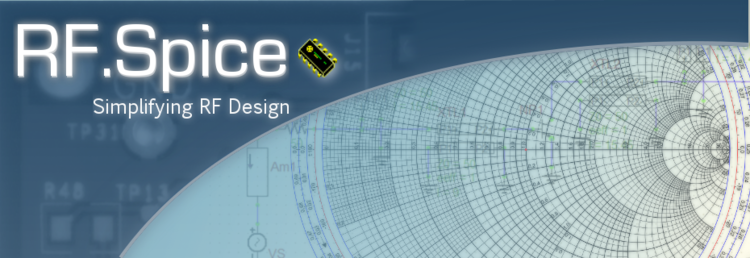Difference between revisions of "RF.Spice A/D"
From Emagtech Wiki
Kazem Sabet (Talk | contribs) (→RF.Spice A/D Tutorial) |
Kazem Sabet (Talk | contribs) (→RF.Spice A/D Tutorial) |
||
| Line 52: | Line 52: | ||
* [[RF.Spice A/D Tutorial Lesson 3 | RF.Spice A/D Tutorial Lesson 3: Analyzing a Bipolar Junction Transistor (BJT) Circuit]] | * [[RF.Spice A/D Tutorial Lesson 3 | RF.Spice A/D Tutorial Lesson 3: Analyzing a Bipolar Junction Transistor (BJT) Circuit]] | ||
* [[RF.Spice A/D Tutorial Lesson 4 | RF.Spice A/D Tutorial Lesson 4: Building a Three-Input Digital AND Function]] | * [[RF.Spice A/D Tutorial Lesson 4 | RF.Spice A/D Tutorial Lesson 4: Building a Three-Input Digital AND Function]] | ||
| + | * [[RF.Spice A/D Tutorial Lesson 5 | RF.Spice A/D Tutorial Lesson 5: A Simple Transmission Line Circuit]] | ||
| + | |||
| + | |||
| + | |||
* [[B2_Tutorial5| RF.Spice A/D Tutorial Lesson 5 : Creating a New Part from Your Circuit]] | * [[B2_Tutorial5| RF.Spice A/D Tutorial Lesson 5 : Creating a New Part from Your Circuit]] | ||
* [[B2_Tutorial6| RF.Spice A/D Tutorial Lesson 6 : Creating a Parameterized Subcircuit Part]] | * [[B2_Tutorial6| RF.Spice A/D Tutorial Lesson 6 : Creating a Parameterized Subcircuit Part]] | ||
Revision as of 18:55, 3 August 2015
Welcome to RF.Spice A/D Wiki!
RF.Spice A/D Manual
Below are some links to help you get started using RF.Spice A/D:
- RF.Spice A/D: Getting Started
- Working with Schematic Editor
- An Overview of Analog and Mixed-Mode Circuit Simulation
- An Overview of Digital Circuit Simulation
- An Overview of RF Circuit Simulation
- Running Live Simulations with Circuit Animation
- Analyzing Circuits Using Predefined Tests
- Visualizing Simulation Data Using Graphs and Tables
- Running Parametric Sweeps and Monte Carlo Tests
- Working with the Parts Database & Device Manager
- Creating New Symbols Using Symbol Editor
- Working with Other Applications
Lists & Glassories
- List of RF.Spice A/D Toolbars, Windows & Menus
- List of RF.Spice A/D Keyboard Shortcuts
- List of SPICE Simulation Parameters
- List of Digital Device Parts
- List of Physical Transmission Line Types
- List of Standard Imported RF Devices
- List of Standard Device Symbols & Their Pins
- Glossary of Signal Sources
- Glossary of Markers and Meters
- Glossary of Generic Analog Devices
- Glossary of Generic Digital and Mixed-Mode Devices
- Glossary of Black-Box Blocks
- Glossary of Generic RF Devices
- Glossary of Physical Transmission Lines and Components
RF.Spice A/D Tutorial
Each tutorial lesson listed below walks you through the basic features of RF.Spice A/D covering many different topics. Lessons 1-4 teach you how to set up simple analog and digital circuits, perform various tests and live simulations and visualize the simulation results. In Lessons 5 and 6, you will learn how to create new parts, devices, simulation models and symbols using RF.Spice's versatile Device Editor.
- RF.Spice A/D Tutorial Lesson 1: A Simple Analog Voltage Divider Circuit
- RF.Spice A/D Tutorial Lesson 2: Time and Frequency Analysis of an RLC Filter
- RF.Spice A/D Tutorial Lesson 3: Analyzing a Bipolar Junction Transistor (BJT) Circuit
- RF.Spice A/D Tutorial Lesson 4: Building a Three-Input Digital AND Function
- RF.Spice A/D Tutorial Lesson 5: A Simple Transmission Line Circuit
- RF.Spice A/D Tutorial Lesson 5 : Creating a New Part from Your Circuit
- RF.Spice A/D Tutorial Lesson 6 : Creating a Parameterized Subcircuit Part
- RF.Spice A/D Tutorial Lesson 7 : Analyzing CMOS Logic Circuits
- RF.Spice A/D Tutorial Lesson 8 : Designing Op-Amp Amplifiers
- RF.Spice A/D Tutorial Lesson 9 : Building Your Own Reusable Binary Adder Digital Devices
- RF.Spice A/D Tutorial Lesson 10 : Analyzing an Integrated Circuit Voltage Comparator
- RF.Spice A/D Tutorial Lesson 11 : Exploring Flip-Flops and Sequential Logic Circuits
- RF.Spice A/D Tutorial Lesson 12 : Designing Active Filters Using Op-Amps
- RF.Spice A/D Tutorial Lesson 13 : Designing Low and High Frequency Oscillator Circuits
- RF.Spice A/D Tutorial Lesson 14 : Building Mixed-Mode Circuits and D/A Converters
- RF.Spice A/D Tutorial Lesson 15 : Using Switches to Build Sample-And-Hold Mixed-Mode Circuits
- RF.Spice Tutorial Lesson 1 : A Simple Transmission Line Circuit
- RF.Spice Tutorial Lesson 2 : Network Analysis and Smith Chart
- RF.Spice Tutorial Lesson 3 : Impedance Matching Using Tuning Stubs
- RF.Spice Tutorial Lesson 4 : Analyzing Microstrip Lines, Discontinuities and Filters
- RF.Spice Tutorial Lesson 5 : Designing a Distributed Bandpass Filter Using Coupled Lines
- RF.Spice Tutorial Lesson 6 : Designing a BJT RF Amplifier with Lumped Elements
- RF.Spice Tutorial Lesson 7 : Analyzing Distributed Amplifiers With Imported BJT & FET Models
- RF.Spice Tutorial Lesson 8 : Time Domain Simulation of RF Components and Circuits
- RF.Spice Tutorial Lesson 9 : Analyzing a Communications System Using Virtual Blocks
